Design of a Dual-Polarization Dipole Antenna for a Cylindrical Phased Array in Ku-Band
Abstract
:1. Introduction
2. Design of the Dipole Antenna
3. Design of the Cylindrical Array
4. Conclusions
Author Contributions
Funding
Data Availability Statement
Conflicts of Interest
References
- Mailloux, R.J. Phased Array Antenna Handbook; Artech House: Boston, MA, USA, 2005; p. 185. [Google Scholar]
- Li, H.; Kang, L.; Wei, F.; Cai, Y.M.; Yin, Y.Z. A Low-Profile Dual-Polarized Microstrip Antenna Array for Dual-Mode OAM Applications. IEEE Antennas Wirel. Propag. Lett. 2017, 16, 3022–3025. [Google Scholar] [CrossRef]
- Yang, B.; Huang, H.; Feng, B.; Deng, L. A Dual-Polarized Zhe-Shaped Conformal Patch Antenna for 5G Millimeter-Wave Applications. In Proceedings of the IEEE 4th International Conference on Electronic Information and Communication Technology (ICEICT), Xi’an, China, 18–20 August 2021; pp. 866–868. [Google Scholar]
- Liao, L.; Li, Z.; Tang, Y.; Chen, X. Dual-Polarized Dipole Antenna for Wireless Data and Microwave Power Transfer. Electronics 2022, 11, 778. [Google Scholar] [CrossRef]
- Benny, S.; Sahoo, S. Analysis of Optimized Subarray Configuration for Cross Polarization Reduction for Phased Array Antennas used in Weather Radar. In Proceedings of the IEEE International Symposium on Antennas and Propagation and USNC-URSI Radio Science Meeting (APS/URSI), Singapore, 4–10 December 2021; pp. 519–520. [Google Scholar]
- Wang, X.; Zhou, S.; Liu, H.; Yan, J.; Su, H.; Li, H.; Yin, K.; Sun, W.; Zhou, L. Polarization Parameter Estimation of Conformal MIMO Radar Targets. In Proceedings of the IEEE Radar Conference (RadarConf20), Florence, Italy, 21–25 September 2020; pp. 1–5. [Google Scholar]
- Huai, W.; Yanyan, Z.; Xinghui, P.; Xinying, B. An S/C Dual-Band Dual-Polarization Array for Synthetic Aperture Radar. In Proceedings of the IEEE 9th International Symposium on Microwave, Antenna, Propagation and EMC Technologies for Wireless Communications (MAPE), Chengdu, China, 26–29 August 2022; pp. 184–187. [Google Scholar]
- Kobayashi, T.; Ko, K.; Choi, S.J.; Choi, J.H. Orthogonal Dual Polarization GPR Measurement for Detection of Buried Vertical Fault. IEEE Geosci. Remote Sens. Lett. 2022, 19, 1–5. [Google Scholar] [CrossRef]
- Wang, P.; Wen, G.; Zhang, H.; Sun, Y. A Wideband Conformal End-Fire Antenna Array Mounted on a Large Conducting Cylinder. IEEE Trans. Antennas Propag. 2013, 61, 4857–4861. [Google Scholar] [CrossRef]
- Liu, Y.; Wang, T.; Zhong, P.; Wang, S. Cylindrical conformal broadband array antenna based on defective ground structure. In Proceedings of the IEEE 4th Advanced Information Technology, Electronic and Automation Control Conference (IAEAC), Chengdu, China, 20–22 December 2019; pp. 382–385. [Google Scholar]
- Xia, Y.; Muneer, B.; Zhu, Q. Design of a Full Solid Angle Scanning Cylindrical-and-Conical Phased Array Antennas. IEEE Trans. Antennas Propag. 2017, 65, 4645–4655. [Google Scholar] [CrossRef]
- Zhang, J.; Chai, S.; Xiao, K.; Ding, L.; Zhao, F. Differential feeding technique for full-polarization conformal phased array. In Proceedings of the International Workshop on Electromagnetics: Applications and Student Innovation Competition, London, UK, 30 May–1 June 2017; pp. 87–88. [Google Scholar]
- Lang, L.; Mei, L.; Zhang, N. Design and Simulation of Dual-polarized Non-planar Conformal Phased Array Antenna. In Proceedings of the Photonics & Electromagnetics Research Symposium—Fall (PIERS—Fall), Xiamen, China, 17–20 December 2019; pp. 2385–2392. [Google Scholar]
- Li, J.; Yang, S.; Gou, Y.; Hu, J.; Nie, Z. Wideband dual-polarized magnetically coupled patch antenna array with high port isolation. IEEE Trans. Antennas Propag. 2016, 64, 117–125. [Google Scholar] [CrossRef]
- Xiao, S.; Yang, S.; Zhang, H.; Xiao, Q.; Chen, Y.; Qu, S.-W. Practical Implementation of Wideband and Wide-Scanning Cylindrically Conformal Phased Array. IEEE Trans. Antennas Propag. 2019, 67, 5729–5733. [Google Scholar] [CrossRef]
- Long, X.-P.; Zhou, S.-Z.; Zong, Z.-Y.; Wu, W. Design of Broadband Dual-Polarized Conformal Phased Antenna. In Proceedings of the IEEE International Symposium on Antennas and Propagation and USNC-URSI Radio Science Meeting (APS/URSI), Singapore, 4–10 December 2021; pp. 989–990. [Google Scholar]
- Xiao, Q.; Yang, S.; Bao, H.; Chen, Y.; Qu, S. A wideband dual-polarized conformal phased array based on tightly coupled dipoles. In Proceedings of the Sixth Asia-Pacific Conference on Antennas and Propagation (APCAP), Xi’an, China, 16–19 October 2017; pp. 1–3. [Google Scholar]
- Wang, Y.; Yan, S. Novel Conformal Dipole Antenna with Polarization Diversity for Biomedical Applications. In Proceedings of the International Conference on Microwave and Millimeter Wave Technology (ICMMT), Shanghai, China, 20–23 September 2020; pp. 1–3. [Google Scholar]
- Yan, Y.-D.; Jiao, Y.-C.; Zhang, C.; Zhang, Y.-X.; Chen, G.-T. Hemispheric Conformal Wide Beamwidth Circularly Polarized Antenna Based on Two Pairs of Curved Orthogonal Dipoles in Space. IEEE Trans. Antennas Propag. 2021, 69, 7900–7905. [Google Scholar] [CrossRef]
- Peng, J.-J.; Qu, S.-W.; Xia, M.; Yang, S. Wide-Scanning Conformal Phased Array Antenna for UAV Radar Based on Polyimide Film. IEEE Antennas Wirel. Propag. Lett. 2020, 19, 1581–1585. [Google Scholar] [CrossRef]
- Gao, Y.; Jiang, W.; Hu, W.; Wang, Q.; Zhang, W.; Gong, S. A Dual-Polarized 2-D Monopulse Antenna Array for Conical Conformal Applications. IEEE Trans. Antennas Propag. 2021, 69, 5479–5488. [Google Scholar] [CrossRef]
- Gao, Y.; Jiang, W.; Hong, T.; Gong, S. A High-gain Conical Conformal Antenna with Circularly Polarization and Axial Radiation in X-band. In Proceedings of the 13th European Conference on Antennas and Propagation (EuCAP), Krakow, Poland, 31 March–5 April 2019; pp. 1–4. [Google Scholar]
- Golbon-Haghighi, M.-H.; Mirmozafari, M.; Saeidi-Manesh, H.; Zhang, G. Design of a Cylindrical Crossed Dipole Phased Array Antenna for Weather Surveillance Radars. IEEE Open J. Antennas Propag. 2021, 2, 402–411. [Google Scholar] [CrossRef]
- Hu, J.; Sligar, A.; Chang, C.H.; Lu, S.L.; Settaluri, R.K. A grounded coplanar waveguide technique for microwave measurement of complex permittivity and permeability. IEEE Trans. Magn. 2006, 42, 1929–1931. [Google Scholar]
- Chen, J.S. A CPWG-fed dual-frequency rectangular patch antenna. Microw. Opt. Technol. Lett. 2002, 34, 397–398. [Google Scholar] [CrossRef]

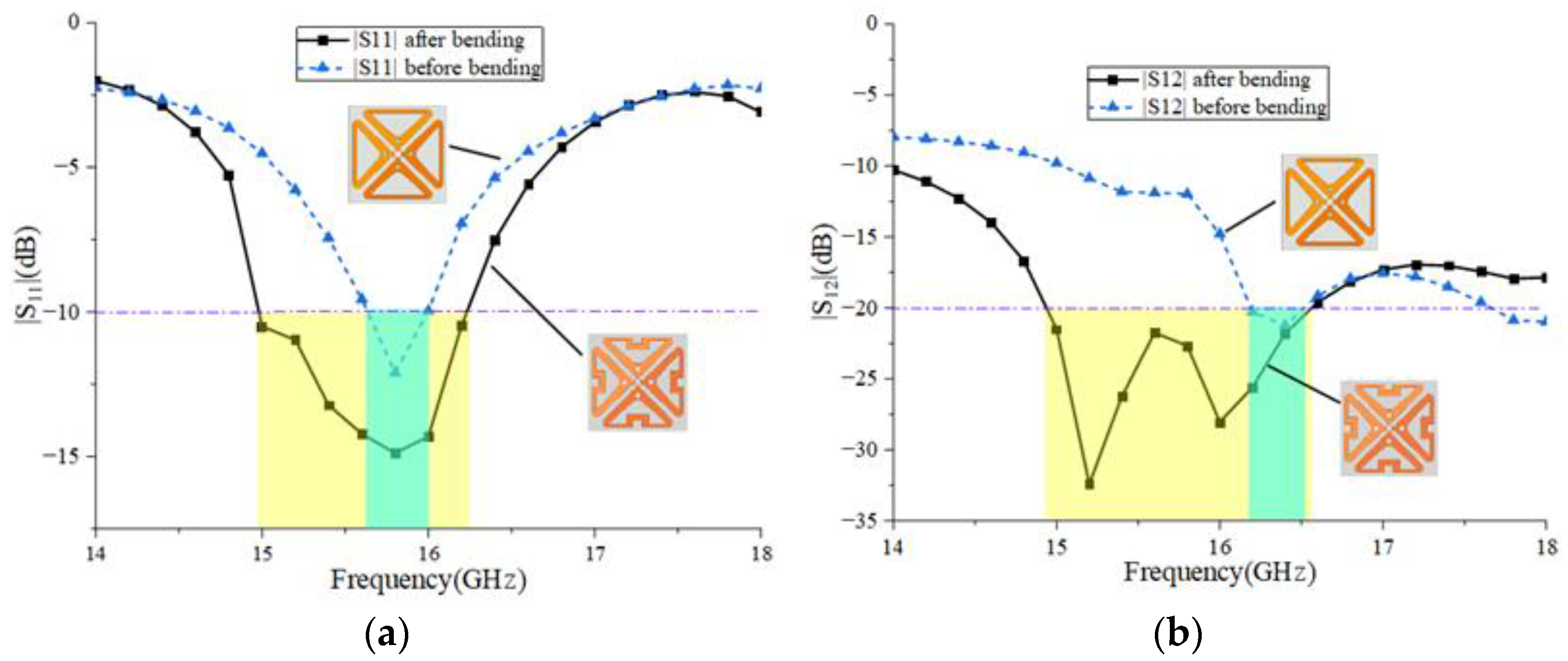

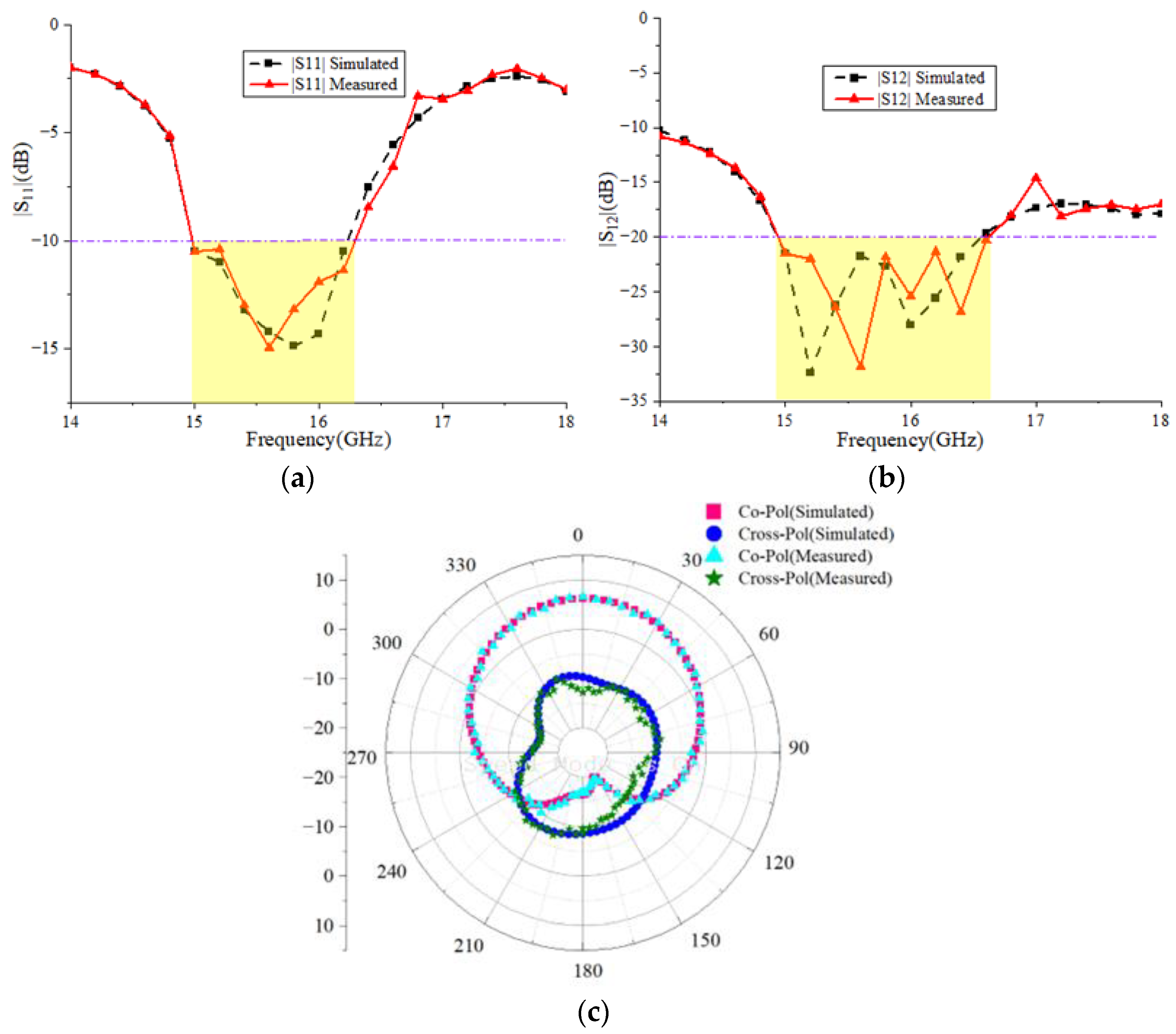


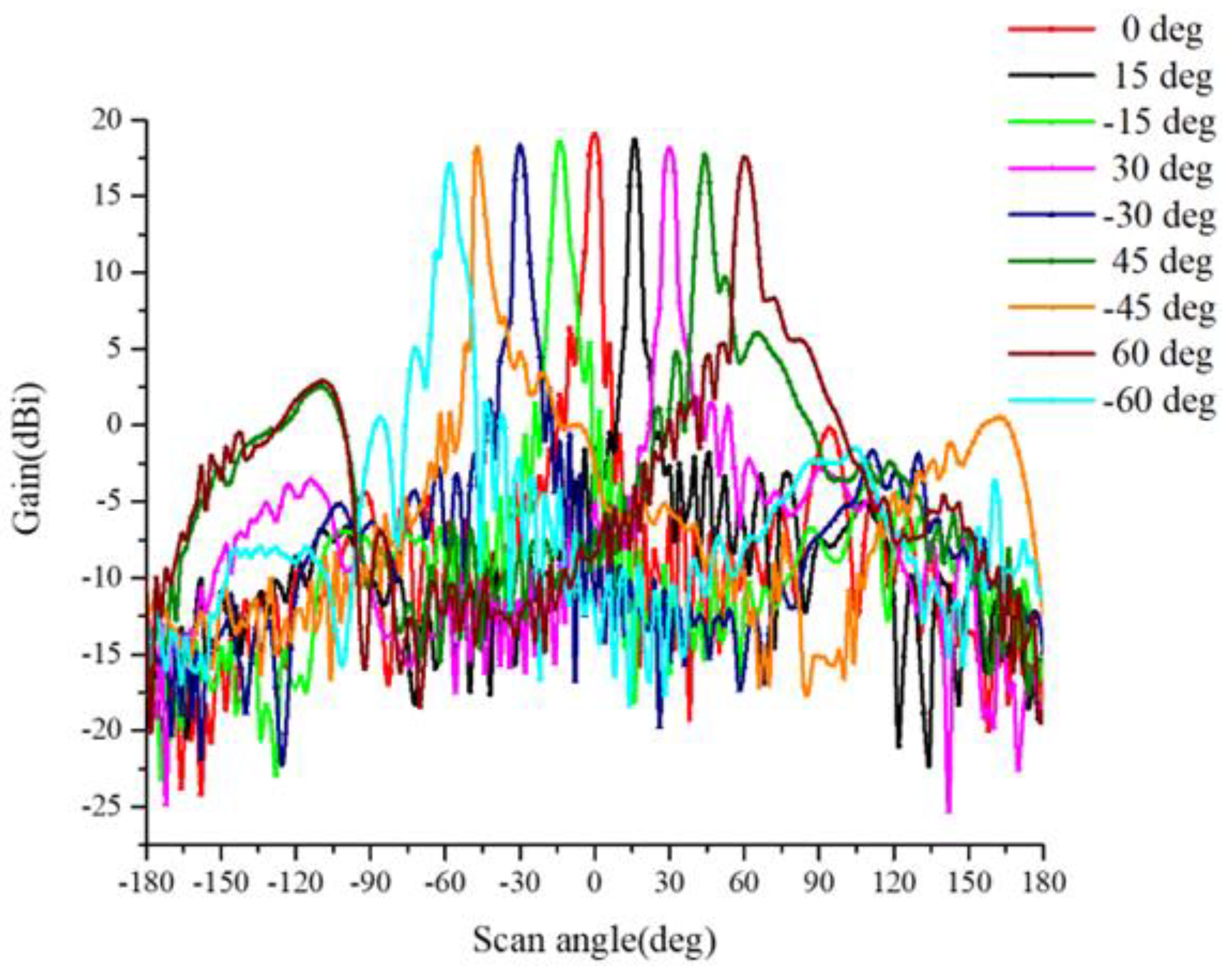
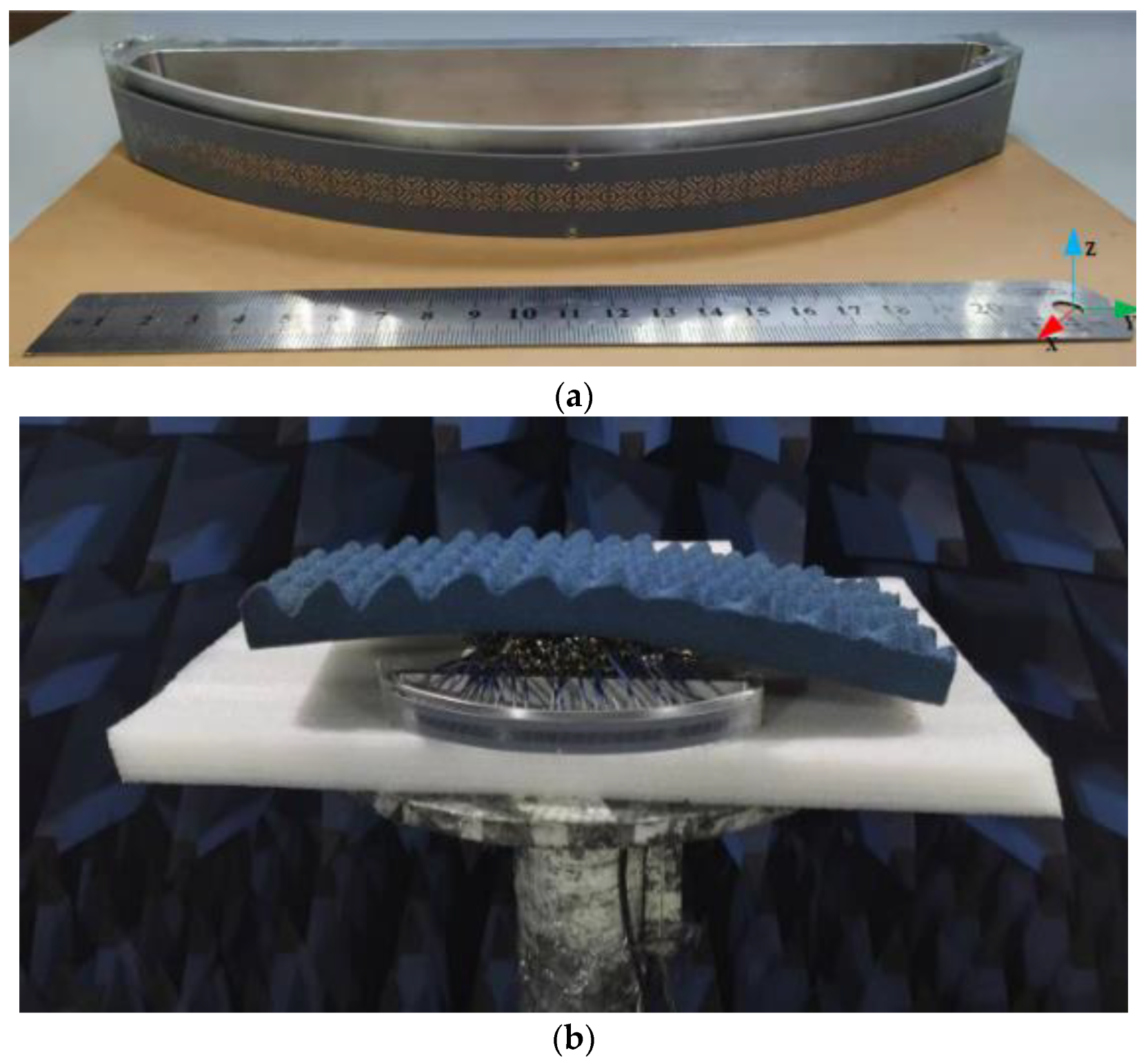
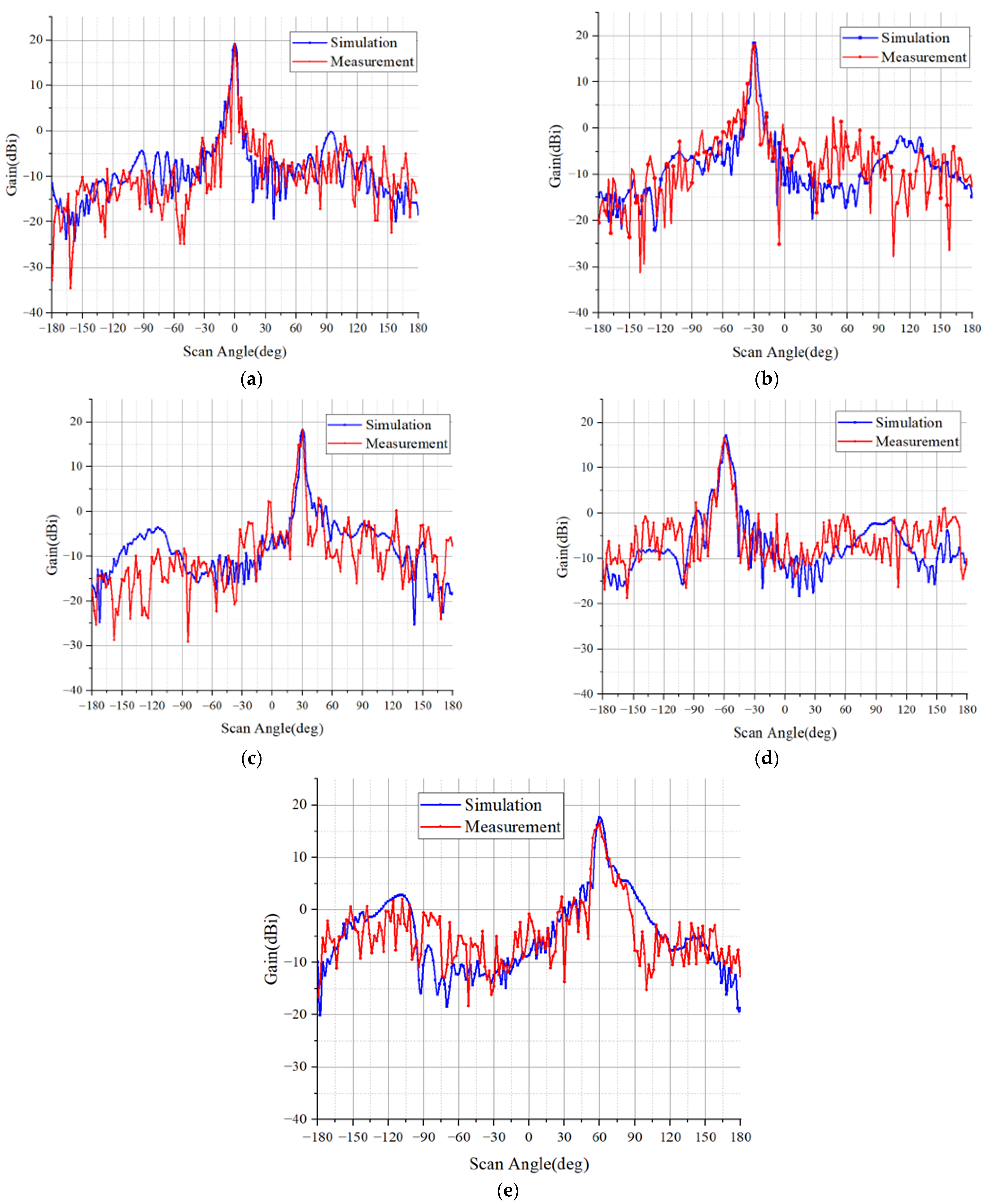
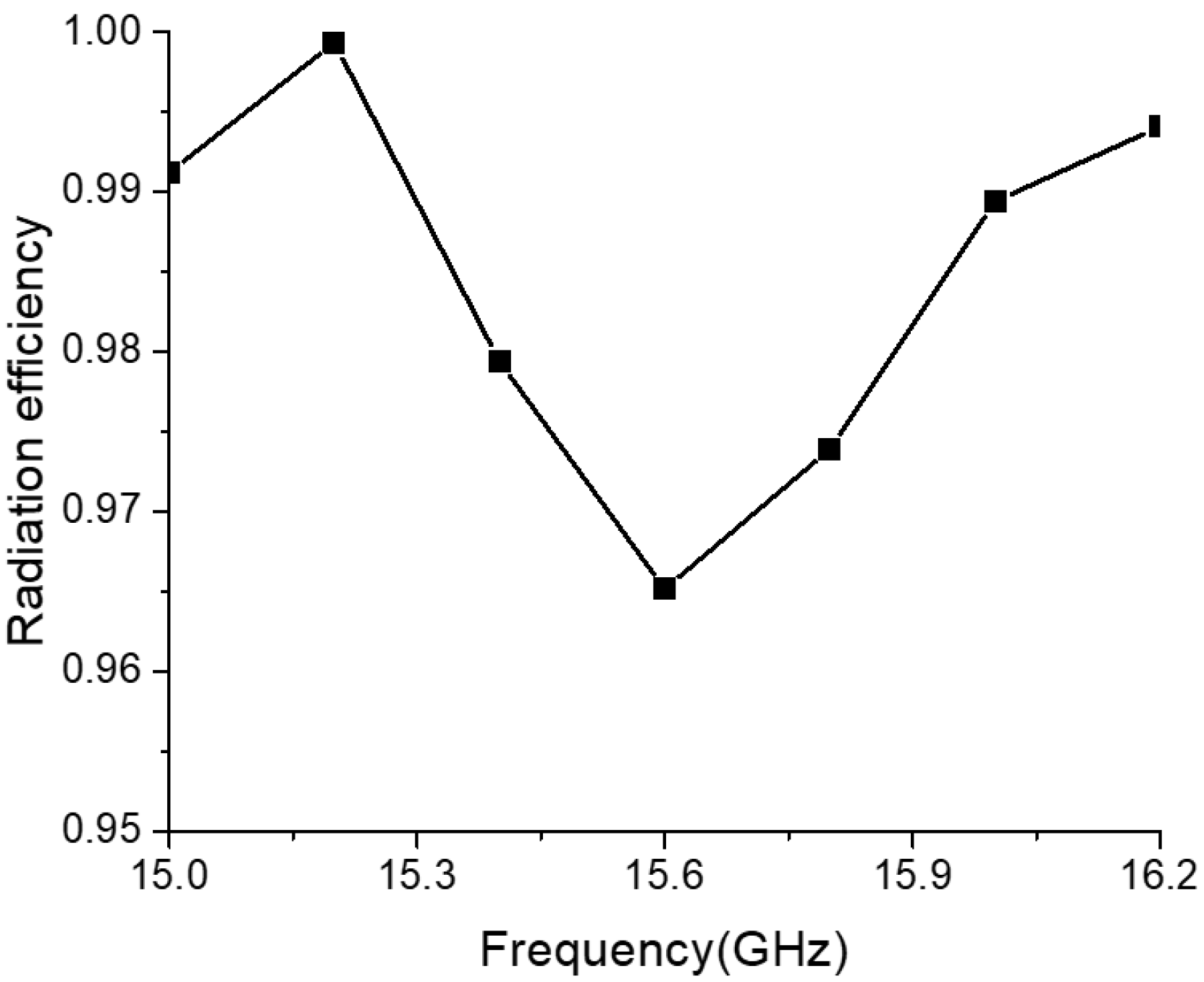
| Parameter | Size | Parameter | Size |
|---|---|---|---|
| L | 3.8 | Rs | 1.9 |
| L1 | 6.25 | Lf1 | 2.54 |
| L3 | 2 | Lf2 | 0.84 |
| L4 | 0.8 | Lf3 | 1.39 |
| L5 | 3 | Wf | 1.1 |
| Ls | 3 | Wf1 | 0.4 |
| W1 | 3 | Ws | 1.21 |
| W2 | 2 | H | 1 |
| Lf | 0.75 |
| −60° | −30° | 0° | 30° | 60° | |
|---|---|---|---|---|---|
| Simulation (dBi) | 17.32 | 18.29 | 19.06 | 18.12 | 17.56 |
| Measurement (dBi) | 16.66 | 17.83 | 18.90 | 17.96 | 16.48 |
| Reference | Bandwidth | Port Isolation | Thickness | Scan Angle | Scan Loss | Gain (Broadside) |
|---|---|---|---|---|---|---|
| [11] | 1.74% | Sigle-polarized | 0.052l0 | −30°~+30° | 1.25 dB | 20.8 dBi |
| [13] | 20.98% | >45 dB | 0.21l0 | −45°~+45° | 1.88 dB | 14.92 dBi |
| [15] | 100% | >17 dB | 0.28l0 | −60°~+60° | 2.5 dB | Not mentioned |
| [23] | 7.14% | >50 dB | 1.05l0 | Switching beam | - | Not mentioned |
| This work | 8.0% | >21 dB | 0.11l0 | −60°~+60° | 2.42 dB | 19.06 dBi |
Publisher’s Note: MDPI stays neutral with regard to jurisdictional claims in published maps and institutional affiliations. |
© 2022 by the authors. Licensee MDPI, Basel, Switzerland. This article is an open access article distributed under the terms and conditions of the Creative Commons Attribution (CC BY) license (https://creativecommons.org/licenses/by/4.0/).
Share and Cite
Zhang, N.; Xue, Z.; Zheng, P.; Gao, L.; Liu, J.Q. Design of a Dual-Polarization Dipole Antenna for a Cylindrical Phased Array in Ku-Band. Electronics 2022, 11, 3796. https://doi.org/10.3390/electronics11223796
Zhang N, Xue Z, Zheng P, Gao L, Liu JQ. Design of a Dual-Polarization Dipole Antenna for a Cylindrical Phased Array in Ku-Band. Electronics. 2022; 11(22):3796. https://doi.org/10.3390/electronics11223796
Chicago/Turabian StyleZhang, Ning, Zhenghui Xue, Pei Zheng, Lu Gao, and Jia Qi Liu. 2022. "Design of a Dual-Polarization Dipole Antenna for a Cylindrical Phased Array in Ku-Band" Electronics 11, no. 22: 3796. https://doi.org/10.3390/electronics11223796
APA StyleZhang, N., Xue, Z., Zheng, P., Gao, L., & Liu, J. Q. (2022). Design of a Dual-Polarization Dipole Antenna for a Cylindrical Phased Array in Ku-Band. Electronics, 11(22), 3796. https://doi.org/10.3390/electronics11223796







